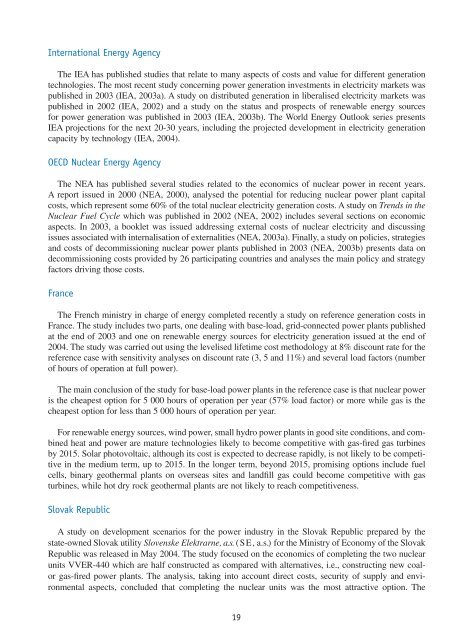Projected Costs of Generating Electricity - OECD Nuclear Energy ...
Projected Costs of Generating Electricity - OECD Nuclear Energy ...
Projected Costs of Generating Electricity - OECD Nuclear Energy ...
You also want an ePaper? Increase the reach of your titles
YUMPU automatically turns print PDFs into web optimized ePapers that Google loves.
International <strong>Energy</strong> Agency<br />
The IEA has published studies that relate to many aspects <strong>of</strong> costs and value for different generation<br />
technologies. The most recent study concerning power generation investments in electricity markets was<br />
published in 2003 (IEA, 2003a). A study on distributed generation in liberalised electricity markets was<br />
published in 2002 (IEA, 2002) and a study on the status and prospects <strong>of</strong> renewable energy sources<br />
for power generation was published in 2003 (IEA, 2003b). The World <strong>Energy</strong> Outlook series presents<br />
IEA projections for the next 20-30 years, including the projected development in electricity generation<br />
capacity by technology (IEA, 2004).<br />
<strong>OECD</strong> <strong>Nuclear</strong> <strong>Energy</strong> Agency<br />
The NEA has published several studies related to the economics <strong>of</strong> nuclear power in recent years.<br />
A report issued in 2000 (NEA, 2000), analysed the potential for reducing nuclear power plant capital<br />
costs, which represent some 60% <strong>of</strong> the total nuclear electricity generation costs. A study on Trends in the<br />
<strong>Nuclear</strong> Fuel Cycle which was published in 2002 (NEA, 2002) includes several sections on economic<br />
aspects. In 2003, a booklet was issued addressing external costs <strong>of</strong> nuclear electricity and discussing<br />
issues associated with internalisation <strong>of</strong> externalities (NEA, 2003a). Finally, a study on policies, strategies<br />
and costs <strong>of</strong> decommissioning nuclear power plants published in 2003 (NEA, 2003b) presents data on<br />
decommissioning costs provided by 26 participating countries and analyses the main policy and strategy<br />
factors driving those costs.<br />
France<br />
The French ministry in charge <strong>of</strong> energy completed recently a study on reference generation costs in<br />
France. The study includes two parts, one dealing with base-load, grid-connected power plants published<br />
at the end <strong>of</strong> 2003 and one on renewable energy sources for electricity generation issued at the end <strong>of</strong><br />
2004. The study was carried out using the levelised lifetime cost methodology at 8% discount rate for the<br />
reference case with sensitivity analyses on discount rate (3, 5 and 11%) and several load factors (number<br />
<strong>of</strong> hours <strong>of</strong> operation at full power).<br />
The main conclusion <strong>of</strong> the study for base-load power plants in the reference case is that nuclear power<br />
is the cheapest option for 5 000 hours <strong>of</strong> operation per year (57% load factor) or more while gas is the<br />
cheapest option for less than 5 000 hours <strong>of</strong> operation per year.<br />
For renewable energy sources, wind power, small hydro power plants in good site conditions, and combined<br />
heat and power are mature technologies likely to become competitive with gas-fired gas turbines<br />
by 2015. Solar photovoltaic, although its cost is expected to decrease rapidly, is not likely to be competitive<br />
in the medium term, up to 2015. In the longer term, beyond 2015, promising options include fuel<br />
cells, binary geothermal plants on overseas sites and landfill gas could become competitive with gas<br />
turbines, while hot dry rock geothermal plants are not likely to reach competitiveness.<br />
Slovak Republic<br />
A study on development scenarios for the power industry in the Slovak Republic prepared by the<br />
state-owned Slovak utility Slovenske Elektrarne, a.s. (SE, a.s.) for the Ministry <strong>of</strong> Economy <strong>of</strong> the Slovak<br />
Republic was released in May 2004. The study focused on the economics <strong>of</strong> completing the two nuclear<br />
units VVER-440 which are half constructed as compared with alternatives, i.e., constructing new coalor<br />
gas-fired power plants. The analysis, taking into account direct costs, security <strong>of</strong> supply and environmental<br />
aspects, concluded that completing the nuclear units was the most attractive option. The<br />
19

















